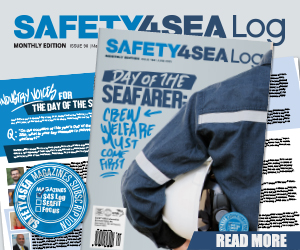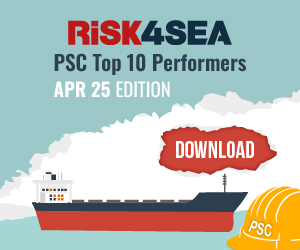NTSB has issued an investigation report into an engine room fire aboard the passenger vessel Ocean Navigator in Portland, Maine that occurred in October 2023.
The incident
On October 18, 2023, at approximately 0710, the passenger vessel Ocean Navigator was moored at the Ocean Gateway Terminal in Portland, Maine, with 210 people aboard when the No. 2 auxiliary diesel generator engine suffered a mechanical failure. The failure caused components to be ejected from the engine and started a fire in the engine room. Crewmembers secured the engine room ventilation, and the fire self-extinguished. One crewmember near the engine at the time was seriously injured. No passengers were injured, and no pollution was reported. The estimated damage to the vessel was $2.4 million.
Analysis
While the passenger vessel Ocean Navigator was docked in Portland, Maine, the vessel experienced a catastrophic engine failure of the no. 2 auxiliary diesel engine, which resulted in an engine room fire.
The crew quickly sealed the engine room by closing watertight doors, shutting off ventilation fans, closing dampers, and activating quick-closing fuel valves to effectively starve the fire of fuel and oxygen, which prevented the spread of the fire. Ultimately, the fire self-extinguished. Additionally, within a few minutes of the fire, the captain notified the crew of the emergency and sounded the general alarm for passengers and crewmembers to proceed to their muster stations. The Ocean Navigator crewmembers followed company procedures to muster all passengers and evacuate them from the vessel without injury. Therefore, the crew’s response was timely and effective in extinguishing the engine room fire and ensuring the safe evacuation of passengers.
After the fire, third-party technicians disassembled all components from the no. 2 auxiliary engine and found the crankshaft, several main bearings, connecting rod bearings, and the no. 14 fuel injector to be damaged. Factory-trained representatives from the engine’s manufacturer inspected the components and noted abnormal wear on the connecting rod bearings and main bearings, which showed signs of cavitation erosion (some considered excessive) and bearing damage from debris, indicating debris had been introduced at some point into the lube oil system.
However, because pre- and postcasualty lube oil analysis indicated the lube oil was suitable for further service (with the exception of abnormally high levels of aluminum in the postcasualty analysis), it is unclear how debris initially entered the lube oil system of the engine.
Debris in the system would have caused scratching or scoring of the inner layer of the bearings (which typically had an aluminum-based alloy layer) as the debris circulated through the rotating components. As the debris wore away the bearing surfaces of the main bearings and connecting rod bearings, the clearances between the components would have begun to increase between the journals, crankshaft, and bearings.
These increased clearances would have allowed more lube oil to flow out the sides of the bearings, reducing oil pressure, allowing excessive movement outside of these clearances, and resulting in a loss of oil film between the rotating components. Without an oil film, the friction of rotating components would have generated excessive heat, causing components, such as the no. 13 connecting rod and the crankshaft, to seize together and fail by welding themselves to the journal.
As the engine continued to run at rated speed (1,800 rpm) and its crankshaft continued to rotate, the no. 13 connecting rod would have locked up and broken away from the crankshaft. Parts from the disconnected connecting rod collided chaotically as the crankshaft continued to turn, damaging other engine components until a portion of the no. 13 connecting rod or other internal components ruptured the engine block near the nos. 12 and 14 cylinders.
Therefore, it is likely that debris entrained in the lube oil system of the no. 2 auxiliary engine led to the catastrophic damage to the engine. As a result of the block rupturing, hot, atomized lube oil vented through the damaged inspection covers and ignited off hot components internal to the engine.
The engineering logbooks for the vessel showed that, in the 2 months before the engine failure, crewmembers added lube oil to the no. 2 auxiliary engine (37 gallons in September and 42 gallons in October). In comparison, the crew added only about 5 gallons of lube oil to the no. 1 auxiliary engine, which operated at the same rpm and with similar load conditions. They also did not add oil to either of the main engines. The need to add significantly more lube oil to replenish the oil in the no. 2 auxiliary engine indicates that the engine was consuming lube oil at a greater rate than all the other engines.
According to the engine manufacturer, when a diesel engine consumes more oil than normal, deposits (debris) can form on the pistons and in the combustion chamber, leading to packing of carbon under the piston rings and wear of the cylinder liner. The need to add significantly more lube oil to replenish the consumed oil in the no. 2 auxiliary engine indicated that there was likely an issue within the no. 2 auxiliary engine—either the engine was burning lube oil or the lube oil purifier was removing a larger quantity of contaminated oil during the purification process.
The crew had last changed the entire quantity of lube oil for the no. 2 auxiliary engine in September 2022—about 13 months before the engine failure—but the engine had operated more than 5,000 hours with this lube oil in the engine, exceeding the manufacturer’s recommendation by 5 times. The manufacturer’s recommendation serves to provide a timeline for when oil is required to be replaced to provide maximum performance of the lube oil and prevent wear to engine components.
Because the crew did not follow the manufacturer-recommended intervals for the frequency of lube oil changes, contaminants, such as debris and chemical corrosives, entrained in the lube oil would have been likely to accumulate—diminishing the lubrication quality—and the effectiveness of additives in the lube oil would have been reduced—diminishing the performance of the lube oil.
Additionally, the crew had last changed the lube oil filter elements in May 2023, when the engine had about 11,000 hours on it. The engine manufacturer provided guidance for the lube oil filter elements to be replaced at every oil change or after the filter elements had been used for 1,000 hours. At the time of the engine failure, the engine had about 14,329 hours on it, indicating the filters had been used for 3,329 hours. This interval exceeded the manufacturer’s recommendation by over 3 times.
The use of a filter beyond the manufacturer’s recommended replacement guidance can result in a clogged filter. If a filter is clogged, the filter’s bypass valve will remain open, preventing the lube oil from passing through the element, and any debris particles entrained in the oil will flow directly into the engine and remain circulating in the lube oil system. Therefore, because the filter elements had not been replaced in accordance with the manufacturer-recommended intervals, the filter elements were less effective than intended.
Probable cause
The National Transportation Safety Board determines that the probable cause of the failure of the no. 2 auxiliary diesel generator engine and resulting engine room fire on board the passenger vessel Ocean Navigator was debris entrained in the engine’s lube oil system—possibly due to the crew exceeding manufacturer-recommended intervals for changing the lube oil and oil filter elements—which caused catastrophic mechanical damage to the engine.
Lessons Learned
Engine rooms contain multiple fuel sources as well as mechanical ventilation, making the spaces especially vulnerable to rapidly spreading fires. After an engine room fire ignites, it is imperative to remove the sources of available fuel and ventilation to the fire to prevent it from spreading. In the engine room fire aboard the Ocean Navigator, the crew’s quick action to secure engine room ventilation and engine fuel sources prevented the spread of fire and ultimately resulted in the fire self-extinguishing. Vessel crews should familiarize themselves and train frequently on machinery, fuel oil, lube oil, and ventilation shutoff systems to quickly act to contain and suppress engine room fires before they can spread to other spaces.
Adhering to manufacturer’s recommended maintenance procedures and intervals
Manufacturers provide maintenance recommendations and intervals (schedules) to ensure equipment operates safely, optimally, and reliably throughout its service life. By regularly reviewing equipment manufacturer manuals and guidance, operators can ensure conformance with recommended maintenance plans and mitigate the risk of equipment malfunction or failure.






























































